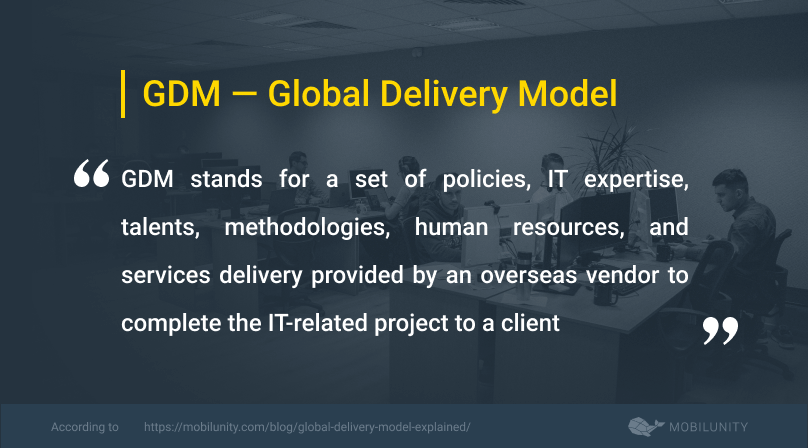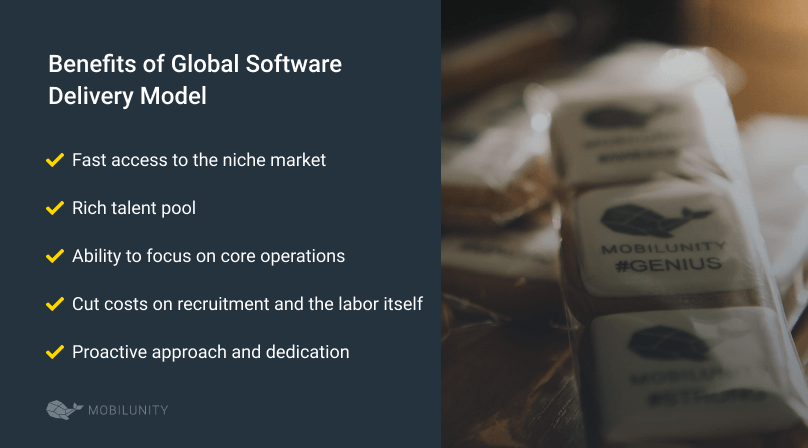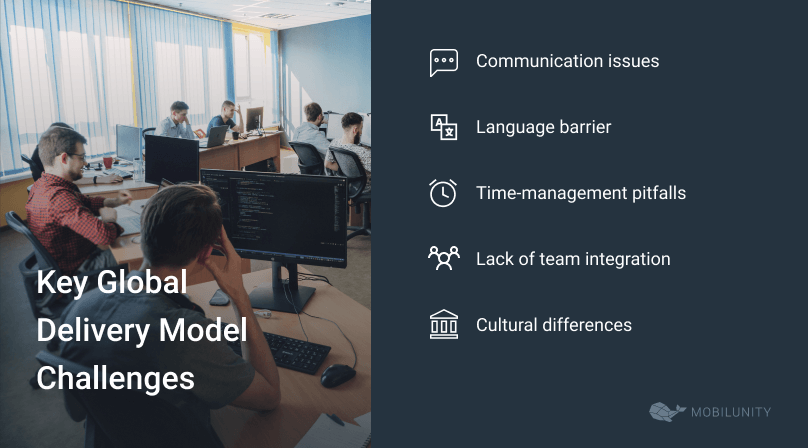GDM (Global Delivery Model)

GDM definition stands for a set of policies, IT expertise, talents, methodologies, human resources, and services delivery provided by an overseas vendor to complete the IT-related project to a client [1]. Usually, all these components are delivered in their entirety according to the principles of GDM meaning and it can considerably optimize the process. GDM mode is a graphical login manager used by many Linux-based operating systems, including Ubuntu and Fedora, to provide users with a graphical interface to log in to their system.
The Global Delivery Model (GDM) revolutionizes project execution by leveraging global talent pools, facilitating seamless collaboration in marketing software development, and ensuring cost-effective and timely delivery of marketing solutions.
GDM Overview: From Past to Present
It is hard to define the exact date when global delivery became popular, but in the 1980s US companies started to look for low-cost labor to satisfy their IT needs. They mainly hired people from India, as back then, it was the cheapest way to outsource development [2]. Global delivery model services are mainly delivered through offshoring and nearshoring outsourcing. The tendencies of using GDM services add to the total IT market share: it was estimated to bring around $92.5 million in 2019 [3].
These days, due to fierce competition in the IT market, companies are willing to save money on labor and, at the same time, remain technologically rich in their operations. With this in mind, they delegate projects to distributed teams, open R&D centers, and thus introduce cutting-edge technology to their products. The most common industry for GDM is IT, for instance, the headquarters of Apple Inc. is in California, the US, while the assembly processes are done in China.
What Does GDM Mean?
The key principle of GDM is delegating the software development to the vendor’s development team. Some companies prefer to outsource employees for subsidiary projects (short-term or less critical for the company’s overall operations) while other organizations set up the project entirely offshore. If appropriately approached, companies leverage numerous advantages of global delivery model that contribute to the overall success.
Offshore outsourcing refers to the practice of developing software in offshore countries by the team provided by a vendor. This model of GDM remains classic and has its peculiarities: all stages of development are taken under control of a vendor, meaning that you will only reach your team directly when the project is completed.
Nearshore outsourcing – a similar model of hiring remote teams, but in close proximity to your in-house team. Usually, the model is preferred by the companies who are planning to visit their developers for personal or business meetings. A distinctive characteristic of this model is that a GDM agency hires you a dedicated development team while you have full control throughout the whole process of software development. This enables you to make changes, control the quality, and watch the timeframe by yourself.
The Benefits of Global Software Delivery Model
To optimize business operations and keep up with the latest business strategies, companies worldwide are inclined to use GDM to develop their software. What are the benefits of this approach?
- Fast access to the niche market. If your product requires a specific audience or specialists for its development, you can find them elsewhere in other countries. Also, GDM helps SMEs to invade the market with new products quickly and successfully [4].
- Rich talent pool. Some countries face a dramatic scarcity of talents, so the best choice is to find the required IT professionals on the global market.
- Ability to focus on core operations. As mentioned earlier, some organizations delegate small projects to remote developers, thus, direct more crucial processes to the in-house members.
- Cut costs on recruitment and the labor itself. GDM company is the one that searches and hires you candidates based on your requirements, needs, and preferences, so no additional expenses are involved in HR management. Many countries, especially in CEE, have considerably lower salary rates if compared to the US.
- Proactive approach, dedication, and effectiveness. If remote teams are managed in accordance with managerial philosophy, you will never face a lack of commitment, the timeframes will be achieved, and the quality will be up to snuff.
Key Strategies and Challenges of GDM
In order to achieve maximum efficiency from the services of global delivery or blended outsourcing model, companies must establish a well-planned and prospective set of strategies to align with business goals and objectives [5]. Here are some common and useful approaches. Incorporating the Global Delivery Model (GDM) into your strategy, it’s essential to hire Salesforce Marketing Cloud developer, as their specialized skills in digital marketing solutions can significantly enhance global projects by ensuring personalized, scalable, and efficient customer engagement across different markets.
Strategies
- Offshore short-term projects for the sake of long-term goals
Development teams hired from GDM will follow your precise requirements, deadlines, and other guidelines to deliver you a quality product and contribute to the overall project.
- Manage the team and stay engaged
Managing remote teams requires you to be engaged in the process as much as you can. You need to establish a trustworthy and reliable relationship with your team to make sure they are (1) satisfied with this cooperation, (2) feel themselves an inevitable part of your organization, (3) provide you quality services in a timely manner. Managing distributed teams of developers deserves a separate chapter, but it wouldn’t be odd to recap: the key to efficient management is to be involved in every stage of development and communication.
- Control the quality
A GDM company does its best to deliver skilled developers, however, you must control the quality of the services to make sure the results meet your expectations. Nearshoring GDM allows you to hire CTO or CTA to take responsibility for the technical specifications of the project.
Challenges
Overcoming a troublesome situation is an inevitable stage of cooperation between two teams located in two countries. Here are some disadvantages of global delivery model that you may expect.
- Communication issues due to poor management or time zones difference
- Language barrier
- Time-management pitfalls
- Unmet expectations due to a lack of team integration with in-house employees
- Cultural differences that lead to disparities in problem-solving situations
GDM Services Best Practices
Globalized production of goods and services has led to a dramatic number of companies using the global delivery system to gain cutting edge technology input. Let’s some of these companies and how they benefit from using global delivery model.
TechGiants (Google, Microsoft, Huawei, ABBYY, FordMotors)
It is a common practice for huge corporations that run a vast number of projects and produce world-known products to keep a part of their operations overseas. For a knowledge-technology expertise expansion, they open their R&D centers across the world, which allows them to collect the best technology-driven input to their services. As of 2019, Alphabet generated around $27 million from R&Ds worldwide [6]. They also promote their brand, enrich target audiences, and boost local economies by opening new job positions for the citizens of offshoring destinations.
SMEs (esurance, Slack, JPay)
Not only successful and world-recognized corporations use GDM services, but it won’t be a surprise that startups and SMEs considerably benefit from offshore outsourcing. For instance, a Swiss-based startup esurance [7] that deals with fintech insurance, currently employs around 16 IT specialists (including CTO, JavaScript developers, and product manager) from Ukraine. The team has proven its loyalty and dedication by cooperating closely with esurance for 2 years and significantly increased the added value for the company.
See Also
References
- https://mobilunity.com/blog/global-delivery-model-explained
- https://www.academia.edu/11676651/Global_Delivery_Models_The_Role_of_Talent_Speed_and_Time_Zones_in_the_Global_Outsourcing_Industry
- https://www.statista.com/statistics/189788/global-outsourcing-market-size
- https://www.researchgate.net/publication/236270163_Hybrid_Models_as_a_Mix_of_Shared_Services_and_Outsourcing_or_Could_Hybrid_Model_Be_the_New_Management_Buzz_in_the_Following_Times
- https://www.researchgate.net/publication/229036126_Offshore_Information_Systems_Outsourcing_Strategies_and_Scenarios_Research_In_Progress
- https://www.statista.com/statistics/507858/alphabet-google-rd-costs
- https://mobilunity.com/our-clients/esurance
















